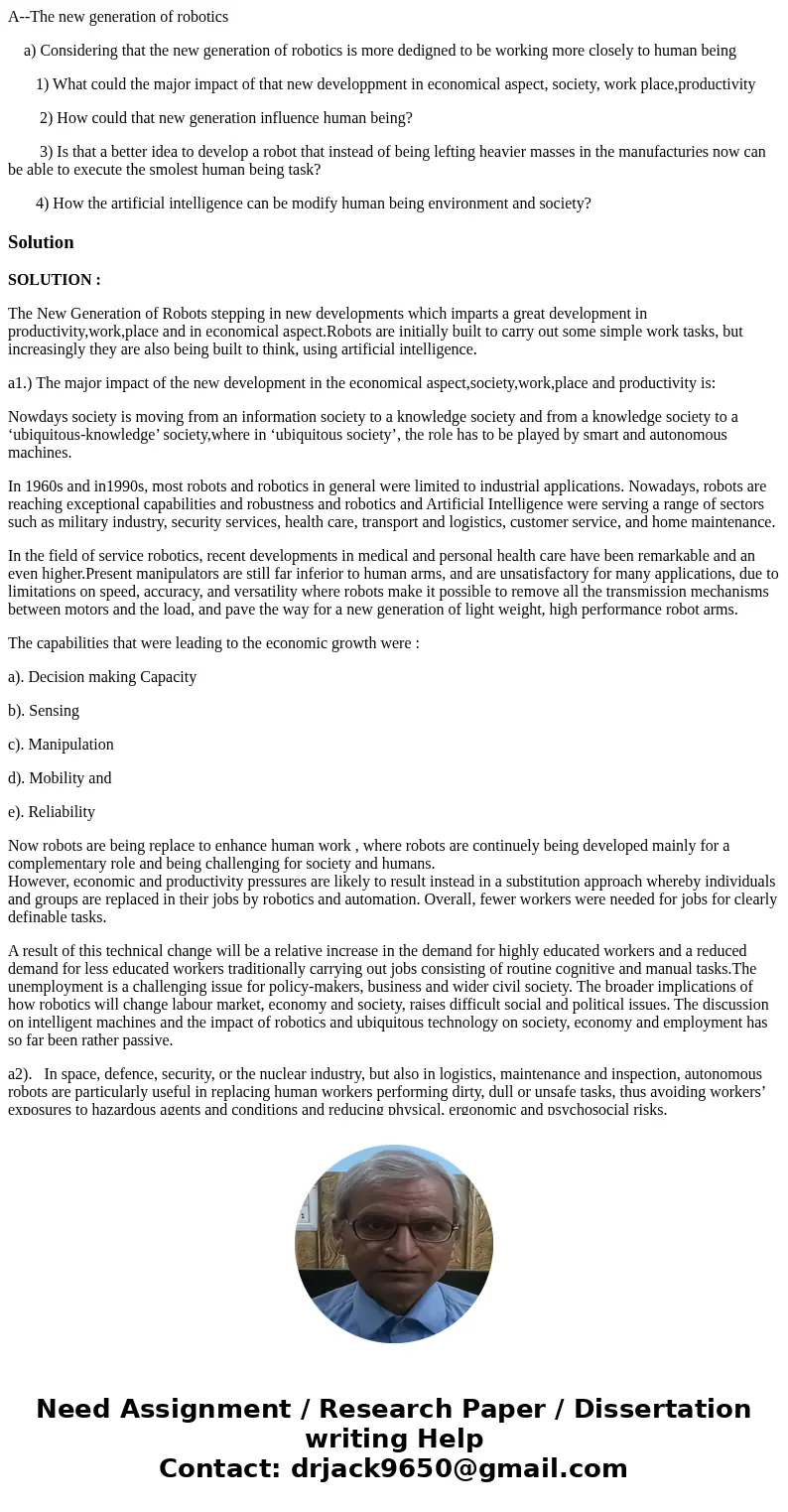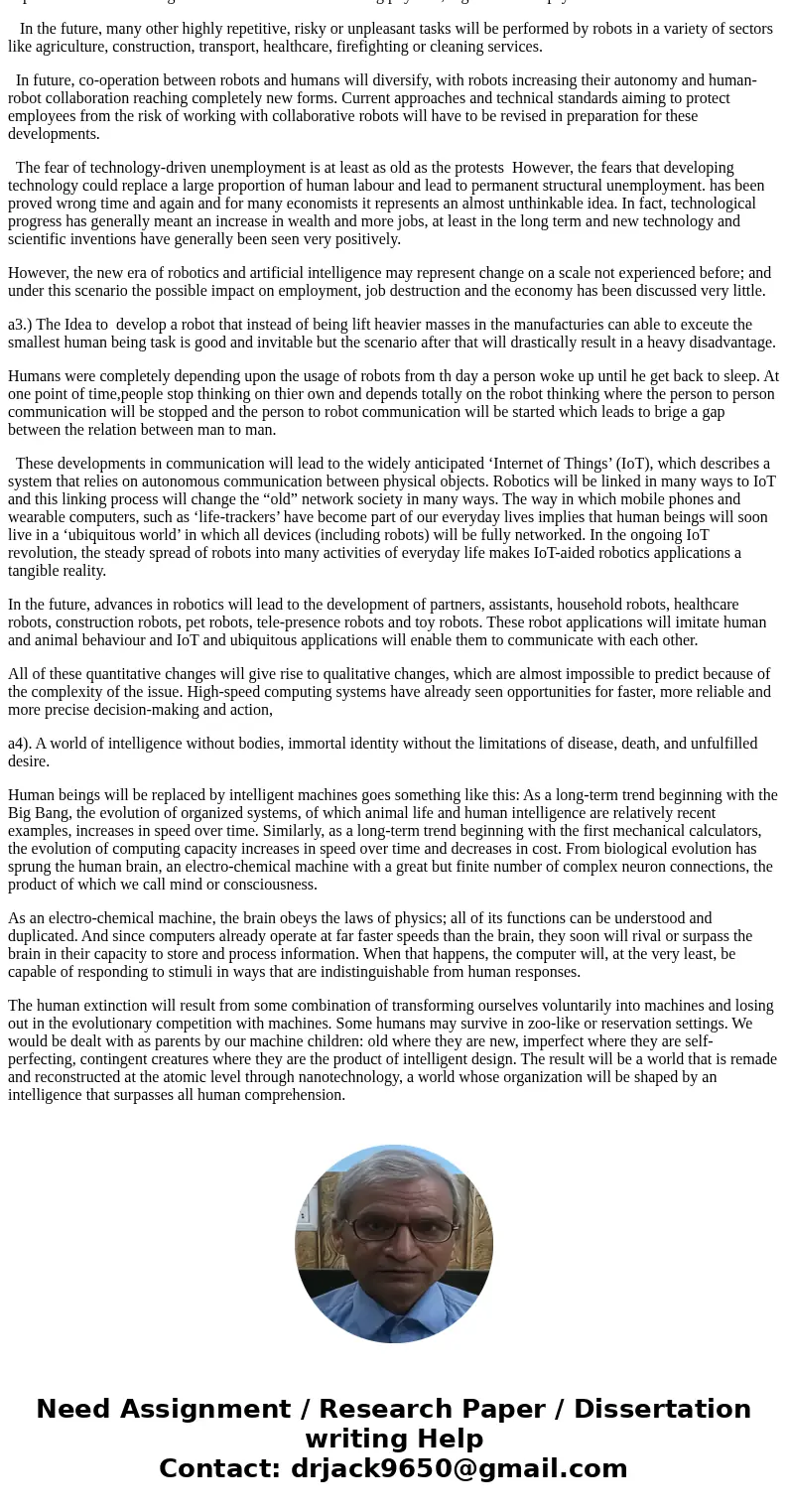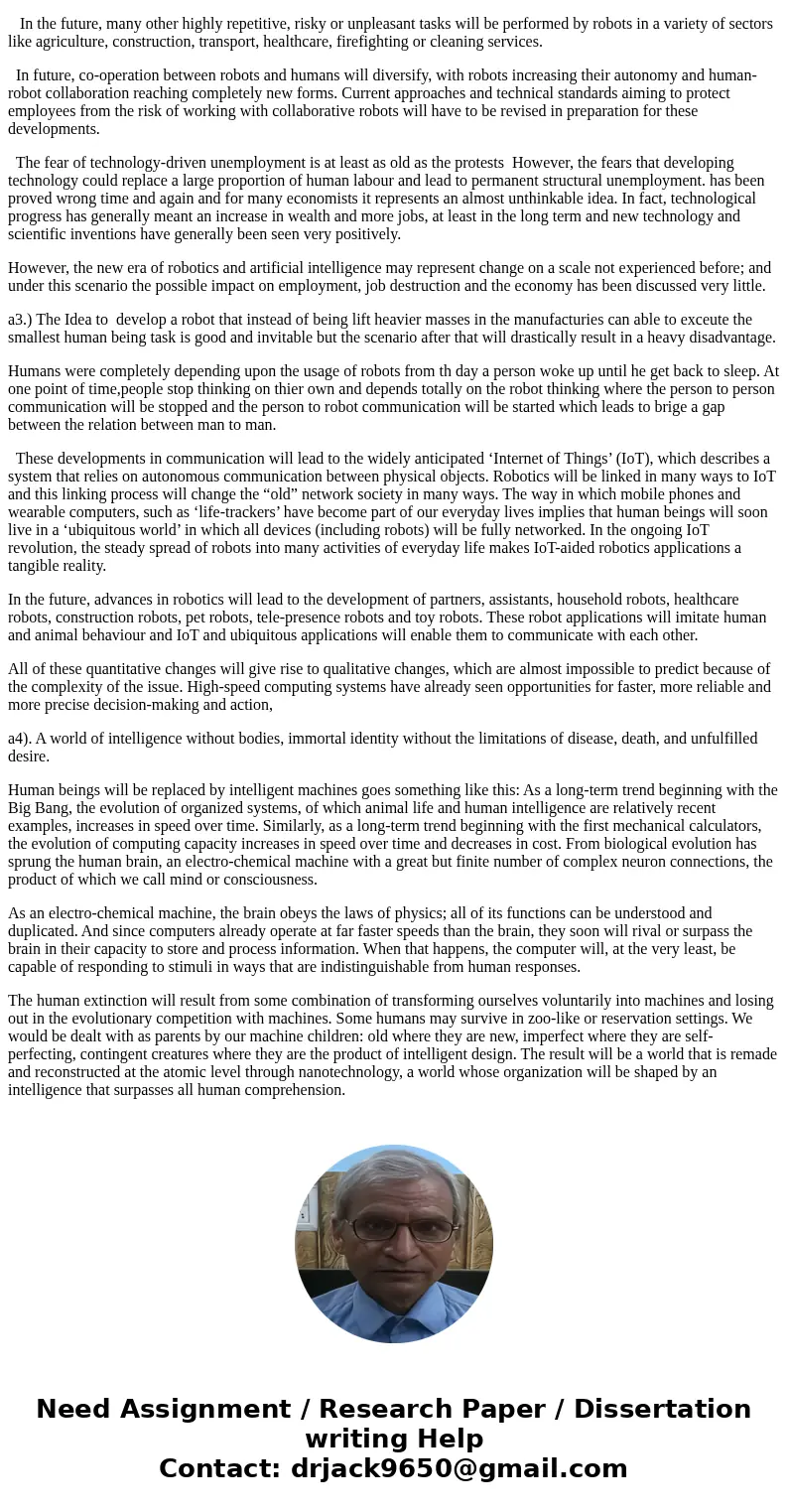AThe new generation of robotics a Considering that the new g
A--The new generation of robotics
a) Considering that the new generation of robotics is more dedigned to be working more closely to human being
1) What could the major impact of that new developpment in economical aspect, society, work place,productivity
2) How could that new generation influence human being?
3) Is that a better idea to develop a robot that instead of being lefting heavier masses in the manufacturies now can be able to execute the smolest human being task?
4) How the artificial intelligence can be modify human being environment and society?
Solution
SOLUTION :
The New Generation of Robots stepping in new developments which imparts a great development in productivity,work,place and in economical aspect.Robots are initially built to carry out some simple work tasks, but increasingly they are also being built to think, using artificial intelligence.
a1.) The major impact of the new development in the economical aspect,society,work,place and productivity is:
Nowdays society is moving from an information society to a knowledge society and from a knowledge society to a ‘ubiquitous-knowledge’ society,where in ‘ubiquitous society’, the role has to be played by smart and autonomous machines.
In 1960s and in1990s, most robots and robotics in general were limited to industrial applications. Nowadays, robots are reaching exceptional capabilities and robustness and robotics and Artificial Intelligence were serving a range of sectors such as military industry, security services, health care, transport and logistics, customer service, and home maintenance.
In the field of service robotics, recent developments in medical and personal health care have been remarkable and an even higher.Present manipulators are still far inferior to human arms, and are unsatisfactory for many applications, due to limitations on speed, accuracy, and versatility where robots make it possible to remove all the transmission mechanisms between motors and the load, and pave the way for a new generation of light weight, high performance robot arms.
The capabilities that were leading to the economic growth were :
a). Decision making Capacity
b). Sensing
c). Manipulation
d). Mobility and
e). Reliability
Now robots are being replace to enhance human work , where robots are continuely being developed mainly for a complementary role and being challenging for society and humans.
However, economic and productivity pressures are likely to result instead in a substitution approach whereby individuals and groups are replaced in their jobs by robotics and automation. Overall, fewer workers were needed for jobs for clearly definable tasks.
A result of this technical change will be a relative increase in the demand for highly educated workers and a reduced demand for less educated workers traditionally carrying out jobs consisting of routine cognitive and manual tasks.The unemployment is a challenging issue for policy-makers, business and wider civil society. The broader implications of how robotics will change labour market, economy and society, raises difficult social and political issues. The discussion on intelligent machines and the impact of robotics and ubiquitous technology on society, economy and employment has so far been rather passive.
a2). In space, defence, security, or the nuclear industry, but also in logistics, maintenance and inspection, autonomous robots are particularly useful in replacing human workers performing dirty, dull or unsafe tasks, thus avoiding workers’ exposures to hazardous agents and conditions and reducing physical, ergonomic and psychosocial risks.
In the future, many other highly repetitive, risky or unpleasant tasks will be performed by robots in a variety of sectors like agriculture, construction, transport, healthcare, firefighting or cleaning services.
In future, co-operation between robots and humans will diversify, with robots increasing their autonomy and human-robot collaboration reaching completely new forms. Current approaches and technical standards aiming to protect employees from the risk of working with collaborative robots will have to be revised in preparation for these developments.
The fear of technology-driven unemployment is at least as old as the protests However, the fears that developing technology could replace a large proportion of human labour and lead to permanent structural unemployment. has been proved wrong time and again and for many economists it represents an almost unthinkable idea. In fact, technological progress has generally meant an increase in wealth and more jobs, at least in the long term and new technology and scientific inventions have generally been seen very positively.
However, the new era of robotics and artificial intelligence may represent change on a scale not experienced before; and under this scenario the possible impact on employment, job destruction and the economy has been discussed very little.
a3.) The Idea to develop a robot that instead of being lift heavier masses in the manufacturies can able to exceute the smallest human being task is good and invitable but the scenario after that will drastically result in a heavy disadvantage.
Humans were completely depending upon the usage of robots from th day a person woke up until he get back to sleep. At one point of time,people stop thinking on thier own and depends totally on the robot thinking where the person to person communication will be stopped and the person to robot communication will be started which leads to brige a gap between the relation between man to man.
These developments in communication will lead to the widely anticipated ‘Internet of Things’ (IoT), which describes a system that relies on autonomous communication between physical objects. Robotics will be linked in many ways to IoT and this linking process will change the “old” network society in many ways. The way in which mobile phones and wearable computers, such as ‘life-trackers’ have become part of our everyday lives implies that human beings will soon live in a ‘ubiquitous world’ in which all devices (including robots) will be fully networked. In the ongoing IoT revolution, the steady spread of robots into many activities of everyday life makes IoT-aided robotics applications a tangible reality.
In the future, advances in robotics will lead to the development of partners, assistants, household robots, healthcare robots, construction robots, pet robots, tele-presence robots and toy robots. These robot applications will imitate human and animal behaviour and IoT and ubiquitous applications will enable them to communicate with each other.
All of these quantitative changes will give rise to qualitative changes, which are almost impossible to predict because of the complexity of the issue. High-speed computing systems have already seen opportunities for faster, more reliable and more precise decision-making and action,
a4). A world of intelligence without bodies, immortal identity without the limitations of disease, death, and unfulfilled desire.
Human beings will be replaced by intelligent machines goes something like this: As a long-term trend beginning with the Big Bang, the evolution of organized systems, of which animal life and human intelligence are relatively recent examples, increases in speed over time. Similarly, as a long-term trend beginning with the first mechanical calculators, the evolution of computing capacity increases in speed over time and decreases in cost. From biological evolution has sprung the human brain, an electro-chemical machine with a great but finite number of complex neuron connections, the product of which we call mind or consciousness.
As an electro-chemical machine, the brain obeys the laws of physics; all of its functions can be understood and duplicated. And since computers already operate at far faster speeds than the brain, they soon will rival or surpass the brain in their capacity to store and process information. When that happens, the computer will, at the very least, be capable of responding to stimuli in ways that are indistinguishable from human responses.
The human extinction will result from some combination of transforming ourselves voluntarily into machines and losing out in the evolutionary competition with machines. Some humans may survive in zoo-like or reservation settings. We would be dealt with as parents by our machine children: old where they are new, imperfect where they are self-perfecting, contingent creatures where they are the product of intelligent design. The result will be a world that is remade and reconstructed at the atomic level through nanotechnology, a world whose organization will be shaped by an intelligence that surpasses all human comprehension.



 Homework Sourse
Homework Sourse